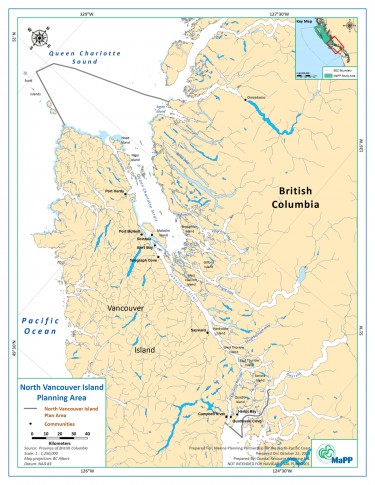Quick Links to the North Vancouver Island Marine Plan, Marine Plan Overview and Annual Report
- North Vancouver Island Marine Plan
- North Vancouver Island Marine Plan Overview
- North Vancouver Island Annual Report 2021-2022
- North Vancouver Island Annual Report 2020
- North Vancouver Island Annual Report 2019
- North Vancouver Island Annual Report 2018
- North Vancouver Island Annual Report 2016-2017
The North Vancouver Island plan area is home to the Kwakw’ka’wakw group of First Nations and lies between northern Vancouver Island and B.C.’s mainland. There are many islands, inlets and fjords within the area, which is characterized by its natural beauty and biodiversity of species and ecosystems. Major water bodies include Queen Charlotte Sound, Queen Charlotte Strait, Johnstone Strait, Smith Inlet, Seymour Inlet, Knight Inlet and Bute Inlet.
This rich marine environment, with glaciated inlets and deep fjords, provides deep waters and unique habitats that support a diverse ecosystem of shellfish and crustaceans, fish species, mammals, marine and shoreline birds, and marine plants. The abundance of marine life includes: crabs, abalone and mussels; salmon, halibut and eulachon; whales, seals and sea lions; auklets, guillemots, and oystercatchers; and ocean plants such as seaweed, kelp and eelgrass. The area contains habitat that is important for the survival of many threatened or endangered species.
The plan area includes traditional territories of five First Nations who are members of the Nanwakolas Council and partners in the MaPP initiative: Mamalilikulla, Tlowitsis, Da’naxda’xw-Awaetlala, Wei Wai Kum and the K’ómoks First Nations. Nanwakolas member nations have a traditional and enduring relationship with the marine environment and its resources. The ocean has shaped these nations’ culture and society, and continues to be the basis of food, social and ceremonial practices and economic wealth.
North Vancouver Island includes the marine areas of the regional districts of Mount Waddington and Strathcona between Vancouver Island and the mainland. Population centres include Port Hardy, Port McNeill, Alert Bay, Sayward and Campbell River. Population is estimated at approximately 40,ooo.
Marine employment in the region includes shellfish and finfish aquaculture, commercial fishing, seafood processing, log handling and storage, tourism (such as kayaking and sport-fishing charters) and transportation.








